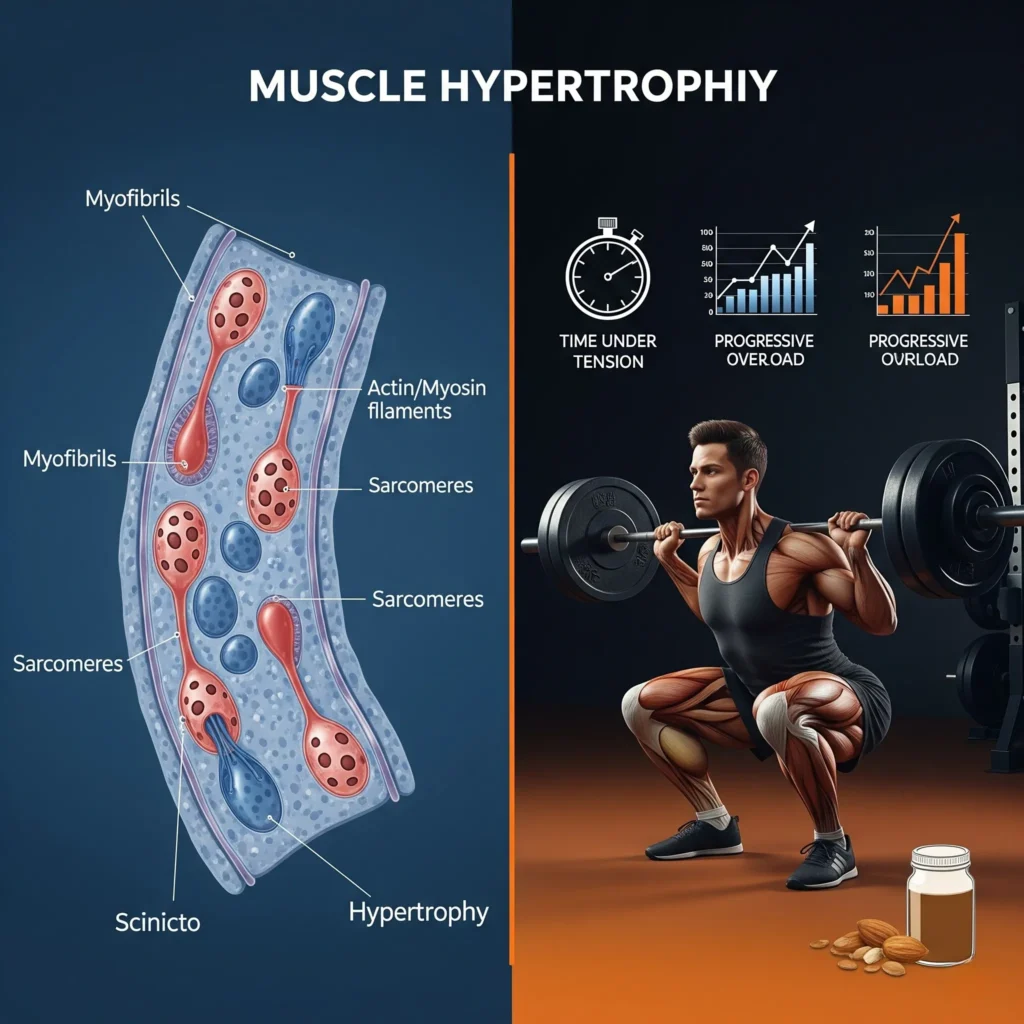
Chasing muscle growth can feel like navigating a maze of conflicting advice and bro-science myths! I’ve spent over 15 years experimenting with countless hypertrophy methods, making every mistake imaginable along the way. In this comprehensive guide, I’ll share what actually works according to both cutting-edge research and real-world application. Did you know that according to a 2024 meta-analysis, properly structured hypertrophy training can produce up to 12% more muscle growth than traditional strength training in intermediate lifters? Whether you’re just starting your muscle-building journey or looking to break through stubborn plateaus, this science-based approach to hypertrophy will transform your training and results!
Understanding Muscle Hypertrophy: The Science Behind Growth
When I first started lifting, I thought muscle growth was simple – just lift heavy things and eat a lot of protein. Boy, was I wrong! The science behind hypertrophy is actually pretty fascinating once you dive into it.
Muscle growth happens through two primary types of hypertrophy: myofibrillar and sarcoplasmic. Myofibrillar hypertrophy involves increasing the number and size of myofibrils (the contractile proteins that do the actual work), while sarcoplasmic hypertrophy increases the fluid and energy substances around the muscle fibers. I used to chase only one type, not realizing both matter for complete development!
There are three main mechanisms that trigger muscle growth. First is mechanical tension – basically how hard your muscles work against resistance. I remember when I first learned that time under tension mattered more than just moving weight from A to B – totally changed my approach! The second mechanism is metabolic stress – that burning, pumped feeling you get during higher rep sets. The third is muscle damage, which isn’t about being sore (a misconception I held for years), but rather the microscopic tears that signal your body to adapt and grow stronger.
Protein synthesis is where the magic happens. After training, your body increases the rate at which it builds new proteins in the damaged muscle tissue. What I didn’t understand for years is that this response only lasts about 24-48 hours after training. That’s why training frequency matters so much!
The genetic component of hypertrophy used to frustrate me to no end. Some people just respond better to training – they have more favorable muscle fiber types, better hormone profiles, or longer muscle bellies. I spent years being jealous of those “genetic freaks” before I learned to focus on maximizing MY personal response. Trust me, understanding your own genetic strengths can help you design a more effective program!
Recent research on mTOR pathways and anabolic signaling has revealed so much about how our muscles respond to different training stimuli. I geek out on this stuff now, but wish I’d understood earlier that different training techniques activate different pathways. It’s not just about lifting heavy – it’s about strategically activating multiple growth signals!
Optimal Training Volume for Maximum Muscle Growth
Volume was my biggest training mistake for YEARS! I used to think more was always better, ending up overtrained and frustrated with minimal results. If you take nothing else from this section, understand that training volume is the primary driver of hypertrophy – but there’s an optimal range.
Training volume is typically measured as sets × reps × weight, though many researchers simplify to just counting hard sets per muscle group per week. The current research suggests that beginners can grow with as little as 6-8 hard sets per muscle group weekly (minimum effective volume or MEV), while more advanced lifters might need upwards of 20+ sets to continue making progress.
Here’s something I wish someone had told me: there’s a sweet spot between doing too little (no stimulus for growth) and too much (cannot recover properly). This is the range between your minimum effective volume and maximum recoverable volume (MRV). My mistake was always pushing past my MRV, thinking I was being hardcore, when I was actually compromising my gains!
After lots of trial and error, I’ve found that most intermediate lifters do best starting around 12-16 sets per muscle group per week. But don’t just copy this number! Your personal recovery capacity, nutrition, sleep quality, and stress levels all affect how much volume you can handle. I’ve coached people who thrive on 10 sets weekly and others who need 18+ for the same muscle group.
Volume distribution across your training week matters tremendously. I used to do one massive chest workout with 20 sets on Monday and wonder why I wasn’t growing optimally. Now I know that spreading that volume across 2-3 sessions (maybe 6-8 sets per workout) yields much better results for most people. The protein synthesis response from a single session tops out after about 5-9 hard sets for most muscle groups!
Progressive volume increases are crucial for continued growth. When you plateau (which happens to EVERYONE), adding sets in the 10-20% range can restart progress. I typically add one set per exercise every 4-6 weeks during a hypertrophy phase, backing off during deloads. This systematic approach beats randomly adding more work when you’re feeling good!
Intensity Techniques That Trigger Hypertrophy
Let’s talk intensity – and I don’t mean screaming and slamming weights! In the scientific sense, intensity refers to the percentage of your one-rep max (1RM) or more practically, your rating of perceived exertion (RPE). This was a game-changer for me once I understood it properly.
For years I trained every set to absolute failure because I thought that’s what the bodybuilding magazines meant by “intensity.” Big mistake! Research now shows that stopping 1-2 reps short of failure (RPE 8-9) on most sets actually optimizes the stimulus-to-fatigue ratio. You get almost the same growth stimulus without burning yourself out!
That said, there IS a place for intensity techniques that push beyond normal limits. Drop sets were my introduction to this world – I still remember my first proper drop set on lateral raises and not being able to brush my teeth the next day! When you reduce the weight by 20-30% and continue immediately for another mini-set, you create enormous metabolic stress and recruit additional muscle fibers.
Rest-pause training is another technique I love for stubborn body parts. Instead of doing a traditional 3×10, try a total rep goal of 30 reps with mini breaks. You might get 15 reps, rest 15 seconds, get 8 more, rest again, and finish with 7. This approach allows you to use heavier weights for more total reps, creating both mechanical tension and metabolic stress.
One technique that’s completely transformed my posterior chain development is emphasizing the eccentric (lowering) portion of lifts. I spent years focused only on lifting the weight, not controlling it down. Now I know that eccentric training causes unique muscle damage signals that promote growth. Try 4-5 second lowering phases on your next leg or back day – you’ll be sore in places you forgot existed!
Periodizing your intensity is crucial for long-term progress. I used to try to train at maximum intensity year-round and always hit a wall after 6-8 weeks. These days, I cycle between phases of moderate intensity (RPE 7-8) higher volume, and shorter phases of higher intensity (RPE 9-10) with slightly reduced volume. This undulating approach keeps progress coming while managing fatigue.
Rep Ranges and Tempo: Fine-Tuning Your Hypertrophy Training
The old bodybuilding dogma that you must train in the 8-12 rep range for growth had me stuck for years! While that range is certainly effective, current research shows muscle hypertrophy occurs across a much wider spectrum than previously thought.
I’ve found that different muscle groups actually respond better to different rep ranges. My quads explode with high-rep work (15-20), while my traps and lats respond better to heavier loads in the 6-8 range. This likely relates to fiber type distribution – and it took me years of experimentation to figure out these personal response patterns.
Time under tension (TUT) has become a key focus in my training. Rather than just counting reps, I think about how long the muscle is working. A typical hypertrophy set should last between 40-70 seconds total for optimal growth stimulus. I used to rush through sets in 20-30 seconds and wonder why my growth stalled!
Rep tempo is something I completely overlooked for nearly a decade of training. I was that guy bouncing the bar off my chest on bench press! Now I know that controlling the eccentric (lowering) and avoiding momentum dramatically increases tension on the target muscles. My current approach for most isolation exercises is a 2-0-1-0 tempo: 2 seconds down, no pause, 1 second up, no pause at the top.
The explosive vs. controlled debate really depends on the movement and your goals. For compound movements like squats, a controlled but not super-slow eccentric followed by an intentionally powerful concentric can maximize both strength and size gains. I nearly injured myself trying to do super-slow training on everything after reading an article about it. Don’t make my mistakes – match tempo to the exercise!
Individualizing rep ranges based on your dominant fiber type has been revolutionary for my training. Notice you get a ridiculous pump with higher reps but minimal growth? You might be more slow-twitch dominant in that muscle group. Finding your personal “sweet spot” in terms of rep ranges requires experimenting with different protocols for 4-6 week blocks and tracking your results meticulously.
Exercise Selection: Choosing the Best Movements for Growth
Exercise selection was probably my biggest blind spot when I started chasing hypertrophy. I thought the “big three” (bench, squat, deadlift) were all I needed because that’s what the powerlifters said. While compound movements are indeed the foundation of any good program, optimal hypertrophy requires more nuance.
The compound vs. isolation debate isn’t actually an either/or proposition. Compounds give you the most bang for your buck, creating tension across multiple muscle groups and allowing you to move the most weight. But isolation exercises allow you to target specific muscles that might be lagging or not getting fully stimulated during compounds. My approach now is about 70% compound, 30% isolation work – a ratio I wish I’d adopted much earlier!
Exercise variation is crucial for complete development. I embarrassingly trained bench press three times weekly for years with minimal chest growth. Turns out, different angles and movement patterns recruit different portions of the muscle. Now I ensure I’m hitting muscles from multiple angles – incline, flat, and decline for chest, or various row angles for back.
Biomechanical efficiency matters tremendously. Some exercises just match your individual structure better than others. For example, my long femurs make back squats awkward, but I thrive with front squats and hack squats. It took me way too long to stop forcing exercises that didn’t suit my body! Now I test movements by asking: “Do I feel this primarily in the target muscle, or am I compensating with other body parts?”
For those stubborn muscle groups (we all have them), you might need special approaches. My side delts refused to grow until I prioritized them earlier in workouts and added specialization techniques like partial reps and extended sets. Sometimes the solution isn’t working harder but working smarter with better exercise selection!
When choosing exercises for each muscle group, I think in terms of a hierarchy. For chest development, for example, I’d rank exercises from most to least effective (for most people): 1) incline dumbbell press, 2) flat barbell bench, 3) dips, 4) cable flyes, etc. Prioritize the movements that give you the best stimulus-to-fatigue ratio for your unique body.
Split Routines vs. Full-Body Training for Hypertrophy
Training splits were a source of endless confusion for me early on. I’d jump from a bro split to full body to push/pull without understanding the principles behind each approach. Now I know that the best split is the one that allows optimal frequency, volume, and recovery for YOUR situation.
Research increasingly shows that training each muscle group 2-3 times per week is optimal for most people seeking hypertrophy. This completely contradicts the once-weekly “destroy and recover” bro split I followed for years! Higher frequency allows you to distribute your weekly volume, potentially improve technique through more practice, and take advantage of the 24-48 hour elevated protein synthesis window.
Push/Pull/Legs (PPL) has become my go-to split for intermediate and advanced lifters because it balances frequency, volume, and recovery well. Running it as a 6-day routine (PPLPPL-rest) allows hitting each muscle group twice weekly with adequate recovery. When I’m more pressed for time, I’ve found that an Upper/Lower split 4 days per week also works exceptionally well.
Full-body routines aren’t just for beginners! I’ve used 3-day full-body splits during busy periods of my life with great success. The key is managing total volume per session and exercise selection to avoid excessive fatigue. These routines work especially well for those with limited training time or recovery capacity.
Your individual recovery ability should dictate your split choice. I’ve coached people who thrive on high-frequency approaches (training muscles 3-4× weekly with lower volume per session) and others who do better with moderate frequency (2× weekly with more volume per session). Factors like sleep quality, nutrition, stress levels, and age all influence which approach might work best for you.
Recovery Optimization: The Missing Link in Muscle Growth
Recovery is where the actual growth happens, yet it took me a decade to take it seriously! I used to think recovery was just about resting between sets or taking an occasional rest day. Now I understand it’s a comprehensive approach that determines whether your training stimulus translates to actual muscle growth.
Sleep might be the most underrated factor in hypertrophy. During deep sleep phases, growth hormone peaks and protein synthesis accelerates. When I finally prioritized 7-8 hours of quality sleep, my gains accelerated noticeably. I track my sleep quality now as carefully as I track my training performance! Some nights I still struggle with getting enough shut-eye (especially with two young kids), but I’ve found that consistent sleep scheduling and limiting screen time before bed make a huge difference.
Nutrition for recovery extends far beyond just protein intake. I used to think I could train like crazy as long as I drank my protein shake after. Big mistake! Strategic carbohydrate intake around workouts replenishes muscle glycogen and creates an anabolic environment. I’ve found that consuming about 25% of my daily carbs before training and another 25% in the post-workout window dramatically improves my recovery between sessions.
Active recovery methods have been game-changing for maintaining training consistency. Light cardio, mobility work, and even just increased daily walking all enhance blood flow and nutrient delivery to recovering muscles. My personal favorite is 20-30 minutes on the stationary bike at a conversational pace the day after heavy leg sessions – feels counterintuitive but reduces soreness dramatically!
Deloading is something I resisted for years, thinking it was just an excuse to be lazy. Now I program regular deload weeks every 4-6 weeks of hard training, reducing volume by about 50% while maintaining intensity. This approach allows accumulated fatigue to dissipate while maintaining the neuromuscular patterns needed for heavy lifting. The result? I come back stronger and more motivated for the next training block!
Nutrition Fundamentals for Maximum Hypertrophy
Nutrition was my biggest blind spot for years. I thought eating “clean” and getting enough protein was all that mattered. Now I understand that strategic nutrition can dramatically accelerate muscle growth when aligned properly with training.
Protein requirements are higher for those seeking hypertrophy than the general population. Through trial and error (and a lot of research), I’ve found that consuming 1.6-2.2g of protein per kilogram of bodyweight daily supports optimal muscle growth for most people. For me personally, this works out to about 4-5 protein-rich meals spaced throughout the day.
The protein timing debate caused me endless confusion! While the anabolic window isn’t as narrow as once thought, I’ve found benefits from consuming 20-40g of protein within a couple hours of training. More importantly, distributing protein evenly throughout the day (rather than backloading all at dinner) keeps protein synthesis more consistently elevated.
Carbohydrates aren’t the enemy for hypertrophy goals! I spent an embarrassing year trying to build muscle on a low-carb diet and wondered why my training intensity and recovery were terrible. Carbs are the primary fuel for high-intensity training and play a crucial role in recovery. My sweet spot is about 4-6g per kilogram of bodyweight on training days, adjusted based on the volume and intensity of each session.
Strategic caloric surpluses are necessary for optimal growth, but the old “see-food diet” approach led me to gain more fat than necessary. I’ve found that a modest surplus of 300-500 calories above maintenance supports muscle growth while minimizing fat gain for most people. During dedicated building phases, I track my weekly weight gain, aiming for about 0.25-0.5% of bodyweight per week as a sweet spot for muscle growth with minimal fat accumulation.
Supplements have their place, but I wasted hundreds of dollars before learning what actually works. Creatine monohydrate (5g daily), protein powder (for convenience), and perhaps caffeine pre-workout have the strongest evidence behind them. Most everything else offers minimal benefits compared to optimizing your overall nutrition approach first.
Progressive Overload: Structured Approaches for Continued Growth
Progressive overload is the cornerstone of continuous improvement, but I misunderstood it for years! I thought it just meant adding weight to the bar every session, which inevitably leads to plateaus or injuries. There are actually multiple ways to progressively overload your muscles.
Beyond simply adding weight, you can increase sets, reps, decrease rest periods, improve execution quality, or increase range of motion. I now track all these variables rather than obsessing solely over weight. Some of my best growth phases came when I focused on adding 1-2 reps per week with the same weight rather than rushing to add plates!
Tracking progression systematically transformed my training. I used to rely on memory (terrible idea) or scattered notes. Now I use a dedicated training app to log every workout, which allows me to see patterns and make data-driven decisions about when to push harder or back off. Nothing is more motivating than seeing concrete evidence of your improvement over time!
Periodization prevents stagnation by strategically manipulating training variables. I used to train the same way year-round and wonder why I’d plateau after a few months. Now I alternate between hypertrophy blocks (moderate weight, higher volume), strength blocks (heavier weight, lower volume), and deload periods. This cyclical approach has kept me progressing for years when linear progression would have stalled.
Auto-regulation has been revolutionary for my training consistency. Instead of forcing myself to hit predetermined numbers regardless of how I feel, I now use RPE (Rate of Perceived Exertion) to guide my training intensity. On days when I’m feeling stronger, I’ll push harder; on days when recovery is compromised, I’ll back off slightly but still get quality work in. This approach has dramatically reduced injuries and overtraining periods.
When progress stalls (which happens to EVERYONE), having a troubleshooting framework is essential. I systematically assess whether the issue is with training volume, intensity, exercise selection, execution, recovery, or nutrition. Often, the solution isn’t working harder but making a strategic adjustment to break through plateaus. Sometimes it’s as simple as replacing an exercise that’s stopped delivering results with a variation that creates new stimulus!
Common Hypertrophy Mistakes and How to Avoid Them
After 15+ years of training (and countless mistakes), I’ve identified patterns that consistently undermine hypertrophy progress. Ego lifting tops the list – using momentum, partial range of motion, or excessive body English just to move heavier weights. Trust me, your muscles don’t know how much weight is on the bar – they only respond to the tension they experience!
Program hopping is another major pitfall I fell into for years. I’d try a new routine every few weeks because progress inevitably slows after the initial adaptation phase. Now I know that sticking with a well-designed program for 8-12 weeks is necessary to see meaningful results. If you’re constantly changing variables, you can’t accurately assess what’s working!
Neglecting certain movement patterns creates imbalances over time. I embarrassingly trained pressing movements far more than pulling for years (hello, rounded shoulders!). Balancing horizontal and vertical pushing and pulling, hip hinge and knee-dominant lower body exercises, and including rotational movements has not only improved my physique but kept me injury-free.
Recovery mistakes sabotaged my progress for years. Inadequate sleep, poor nutrition, excessive alcohol, and insufficient stress management all undermine the body’s ability to adapt to training stimulus. I’ve learned that recovery isn’t just the absence of training – it’s an active process that requires as much attention as the workouts themselves.
The mindset piece cannot be overlooked. For years, I trained with an all-or-nothing mentality that led to periods of extreme dedication followed by complete burnout. Sustainable progress comes from consistency over time, not extreme efforts that can’t be maintained. Finding intrinsic motivation beyond the mirror has been key to my long-term adherence.
Conclusion
Mastering the science of hypertrophy training isn’t just about lifting heavier weights—it’s about strategic implementation of volume, intensity, exercise selection, and recovery. Throughout this guide, we’ve explored the multifaceted approach required to optimize muscle growth based on current research and proven methods. Remember that consistency with these principles will always trump program-hopping or chasing the latest trends. The most effective hypertrophy training program is one that you can sustain while progressively challenging your muscles through various stimuli. I encourage you to experiment with these methods and find what works best for your unique body and response patterns. What hypertrophy techniques have worked best for you? Share your experiences in the comments below!



